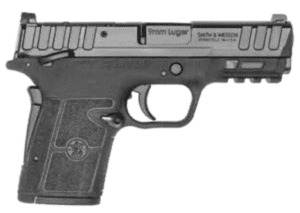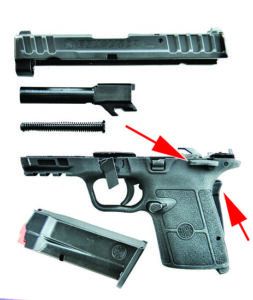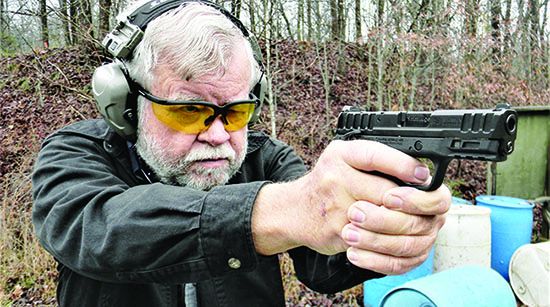The newest and quite popular trend in concealed-carry handguns is to stuff as many 9mm Luger cartridges as possible into as slim a profile as possible. Four guns that incorporate these criteria are the Israeli Weapon Industries (IWI) Masada Slim, the KelTec P15 in both polymer and metal frames, and Smith & Wesson’s new Equalizer.
The Israeli Weapon Industries Masada Slim M9SLIM13, $415, is a subcompact version of the full-size striker-fired polymer Masada. The Slim measures only 1.1 inches in width and weighs only a skosh above 25 ounces loaded. It’s a smaller version of the full-size Masada introduced a few years ago.
KelTec boldly proclaims the new P15 pistol is the slimmest high-capacity handgun out there, and we are hard-pressed to find many that are skinnier. The KelTec P15 Metal P15MBLK, $634, and KelTec P15 Polymer P15BLK, $445, are fresh designs owing nothing to any previous KelTec pistol. We thought availability of the metal-frame P15 would be months behind the polymer P15, but we were able to find an example virtually as soon as the polymer-frame P15 was available. For $189 more on the Metal P15, you get an aluminum frame, an ounce and a half more weight, and lose the ability to mount a combat light.
The Smith & Wesson Equalizer TS 13591, $476, is a high-capacity version of the S&W EZ Rack pistol and the manual-safety version, which we prefer. This is an internal-hammer single-action pistol, and we don’t feel comfortable relying only upon a grip safety. Smith & Wesson entered this potentially lucrative market by upping the capacity of a proven handgun, the Military & Police Shield EZ Rack. We have tested several EZ variations in 380 ACP, 30 Super Carry, and 9mm Luger and have had good results. We were eager to see how the Equalizer would do.
We tested these pistols for combat ability, accuracy, and reliability. There is a balance between affordability and performance, but reliability can never be compromised. In the end, this was a close race. We really liked all four pistols tested, but none had everything we wanted.
Smith & Wesson Equalizer TS 13591 9mm Luger
$476
GUN TESTS GRADE: B
The Equalizer is a good-shooting pistol. We were able to connect at longer range than we would have thought with this lightweight pistol. The good shooting characteristics of this handgun, the ability to mount a red-dot sight, a light rail, and reliability make it a good handgun for personal defense.

| Action Type | Semi-auto hammer fired, single action |
| Overall Length | 6.8 in. |
| Overall Height | 4.9 in. |
| Maximum Width | 1.4 in. |
| Weight Unloaded | 22.9 oz. |
| Weight Loaded | 27.9 oz. |
| Slide | Stainless steel w/black Armornite |
| Slide Retraction Effort | 11.0 lbs. |
| Receiver Material | Black polymer |
| Front Strap Height (w/o magazine) | 1.8 in. |
| Front Strap Height (w 15-rd. magazine) | 3.0 in. |
| Rear Strap Height (w/o magazine) 3.0 in. | |
| Rear Strap Height (w 15-rd. magazine) 3.8 in. | |
| Barrel | 3.675 in. long |
| Grip Thickness Max. | 1.0 in. |
| Grip Circumference | 5.1 in. |
| Magazines | One each 10, 13, and 15 round |
| Rear Sight | Fixed, dual white dot |
| Front Sight | Single white dot |
| Sight Radius | 5.8 in. |
| Trigger Pull Weight | 5.1 lbs. |
| Trigger Span | 2.8 in. |
| Safety | Manual lever |
| Warranty | Limited lifetime |
| Telephone | (800) 331-0855 |
| Website | Smith-Wesson.com |
| Made In | U.S. |
Some have noted that the Equalizer is in many ways a modern update of the concealed-hammer Colt 1903 or Browning 1910. The Colt featured a hidden hammer, and the Browning a grip safety similar to the Colt. These were popular firearms. The Equalizer is a much better and more modern handgun, but it offers similar safety and handling features.
Smith & Wesson’s goal with the Equalizer is to provide a handgun that is easy to load, unload, and shoot accurately enough for personal defense. Racking the slide is relatively easy compared to many other 9mm handguns, with an 11.0-pound slide-retraction effort. However, this was the highest reading in this quartet.
The recoil spring allows good control, another advantage of the pistol’s design. The test gun features a grip safety that prevents the pistol from firing unless the grip safety is fully depressed. If the Equalizer is dropped or the shooter relaxes his grip, the pistol cannot fire. The grip safety is easily depressed as the hand assumes a firing grip. The ambidextrous safety is positive in operation.

The Equalizer features a polymer frame. The frame is actually not as tall as the original EZ Rack design. A double-column magazine gives the pistol more capacity than the slim-line EZ Rack. Yet the frame is only slightly larger, a marvel of modern polymer design. The Equalizer is supplied with 10-, 13-, and 15-round magazines. The slide is optics ready. The Equalizer features forward cocking serrations in addition to well-designed rear cocking serrations. Width is right at an inch, although the safety levers make the pistol incrementally wider at its widest point. While a compact design, the pistol features a 3.675-inch barrel. The Equalizer generated the greatest velocity of the three pistols, but not by a huge margin. At 23 ounces unloaded, the Equalizer is the heaviest pistol tested, although we don’t call it a heavy handgun at all. This made for easy shooting compared to the lighter handguns. The 9mm may not kick much, but when gun weight falls below 20 ounces, recoil is a factor. When executing a speed run on multiple targets, the difference in recoil is more noticeable than when firing for accuracy off hand.
The stainless-steel slide is finished in Armonite. Corrosion should not be a concern. The sights are good high-visibility types with three white dots. Smith & Wesson designed the pistol with a desirable 18-degree grip angle. The grip features a good balance of adhesion and abrasion. We found we could easily operate the safety without changing our firing hold. A good touch is that the Equalizer is supplied with an UPLula magazine loader. We used this loader with all four pistols. Because high-capacity compact magazines feature strong springs, they are often difficult to load to full capacity. The magazine loader was handy to use.
The Equalizer’s single-action trigger isn’t as sharp and tight as we like, but it proved controllable in rapid fire and slow fire as well. The trigger broke at a spongy 5.1 pounds.
We fired the pistol with Federal Syntech and Remington FMJs during the combat and offhand stages. We fired 100 rounds in each pistol in personal-defense shooting drills. The 9mm isn’t a hard kicker, but after firing 400 rounds in two days, you have a well-defined notion of which pistol is most comfortable to fire and use. We used three accuracy loads when firing at 15 yards from a solid benchrest position. These were the Speer 124-grain Gold Dot, Federal 124-grain HST, and Remington 115-grain JHP. Results were good with all three loads. The Speer Gold Dot provided the best accuracy with a nice, tight 1.5-inch group. This would be the best accuracy of the test.
The Equalizer comes on target quickly. Good hits are not difficult to achieve. The sights are good, and the trigger controllable in rapid fire. Recoil isn’t unpleasant. The Equalizer is more pleasant to fire with the 15-round magazine in place. During the combat-shooting phase, we had several failures to fully cycle with the 13-round magazine. We had a cartridge flip up into the ejection port as well. It is asking a lot for a magazine to feed from full compression to almost no compression, but they should have gotten this right. The magazine failed to feed the last three rounds consistently. The 10- and 15-round magazines fed flawlessly. To be certain the ammunition wasn’t the problem, we loaded the 13-round magazine with 124-grain JHP loads with the same results. Once the faulty magazine was isolated, we had good combat results.
Our Team Said: We liked the Equalizer on most levels. It is concealable, light enough, and makes the company’s EZ Rack 9mm obsolete, in our opinion. We rated it down a half grade for the problematic magazine and another half grade for the spongy trigger.
| 9mm LUGER Range Data | ||||
| Remington HTP | Smith & Wesson | KelTec P15 | KelTec P15 | IWI |
| 115-grain JHP 28288 | Equalizer | Polymer | Metal | Masada Slim |
| Average Velocity | 1169 fps | 1155 fps | 1146 fps | 1160 fps |
| Muzzle Energy | 349 ft.-lbs. | 341 ft.-lbs. | 335 ft lbs | 344 ft.-lbs. |
| Smallest Group | 1.5 in | 2.0 in. | 2.0 in. | 1.9 in. |
| Average Group | 2.0 in. | 2.6 in. | 2.7 in. | 2.3 in. |
| Federal HST | Smith & Wesson | KelTec P15 | KelTec P15 | IWI |
| 124-grain JHP P9HST1 | Equalizer | Polymer | Metal | Masada Slim |
| Average Velocity | 1159 fps | 1150 fps | 1141 fps | 1164 fps |
| Muzzle Energy | 370 ft.-lbs. | 364 ft.-lbs. | 358 ft.-lbs. | 373 ft.-lbs. |
| Smallest Group | 1.6 in. | 1.9 in. | 2.1 in. | 1.9 in. |
| Average Group | 2.0 in. | 2.3 in. | 2.4 in. | 2.4 in. |
| Speer Gold Dot | Smith & Wesson | KelTec P15 | KelTec P15 | IWI |
| 124-grain GDHP 2361GD | Equalizer | Polymer | Metal | Masada Slim |
| Average Velocity | 1121 fps | 1098 fps | 1070 fps | 1108 fps |
| Muzzle Energy | 346 ft.-lbs. | 332 ft.-lbs. | 315 ft.-lbs. | 338 ft.-lbs. |
| Smallest Group | 1.5 in. | 1.8 in. | 2.0 in. | 1.8 in. |
| Average Group | 2.2 in. | 2.5 in. | 2.6 in. | 2.3 in. |
Written and photographed by Gun Tests Staff, using evaluations from Gun Tests Team members. GT




























